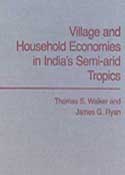|
 This book has been a long time in coming. The hypotheses that guided much of the empirical research were framed in 1974. Data collection started in 1975. But the origin of the book really dates to 1972 when the International Crop Research Institute for the Semi-Arid Tropics(ICRISAT) was founded in Hyderabad, India. ICRISAT was the first new centre formally created in the emerging international agricultural research system.
Its establishment reflected the importance in population and geographic area of rain-fed farming and the semi- arid tropics in world agriculture.
Semi-arid tropical regions are often characterized by scanty and uncertain rainfall, on which agricultural production largely depends, infertile soils, poor infrastructure, extreme poverty, rapid population growth, and high risks. That characterization of neglect also applied to social science research in the semi-arid tropics in the early 1970’s. While India was well endowed with survey information and secondary data, much of it was aggregative, partial, cross-sectional and concentrated on non- SAT regions. A consistent household time series data base on a representative cross section of SAT villages was lacking. Such benchmark households and villages could be used by scientists at ICRISAT and cooperating Indian and overseas research institutions to enhance understanding of development in the Indian SAT and to test hypotheses relevant to the design of technology and policies for the improvement of economic well being.
This book has been a long time in coming. The hypotheses that guided much of the empirical research were framed in 1974. Data collection started in 1975. But the origin of the book really dates to 1972 when the International Crop Research Institute for the Semi-Arid Tropics(ICRISAT) was founded in Hyderabad, India. ICRISAT was the first new centre formally created in the emerging international agricultural research system.
Its establishment reflected the importance in population and geographic area of rain-fed farming and the semi- arid tropics in world agriculture.
Semi-arid tropical regions are often characterized by scanty and uncertain rainfall, on which agricultural production largely depends, infertile soils, poor infrastructure, extreme poverty, rapid population growth, and high risks. That characterization of neglect also applied to social science research in the semi-arid tropics in the early 1970’s. While India was well endowed with survey information and secondary data, much of it was aggregative, partial, cross-sectional and concentrated on non- SAT regions. A consistent household time series data base on a representative cross section of SAT villages was lacking. Such benchmark households and villages could be used by scientists at ICRISAT and cooperating Indian and overseas research institutions to enhance understanding of development in the Indian SAT and to test hypotheses relevant to the design of technology and policies for the improvement of economic well being.
With those purposes in mind, longitudinal village studies were initiated in three important and contrasting production regions in India’s semi-arid tropics in the mid – 1970s. This book is largely about what we learned from those studies. In the early 1980s, the approach was extended to two other regions in India’s SAT and to three regions in West Africa’s SAT.
Because the SAT has not received much attention in the development literature, we felt it was important to document the microeconomic features of India’s SAT which are common to other regions and the more numerous ones which are unique to it. We begin at the microscopic level of individuals and fields, aggregate to socioeconomic groups and villages, and ultimately move to regional contrasts.
Designing research and development strategies in the predominantly rain-fed SAT is not an easy task. It is our hope that the book will heighten the awareness of national policy makers and the international community of both the challenges and opportunities facing the hundreds of million people in SAT India. If it does not, this neglected region may neither realize its full potential nor participate in the gains from national economic growth.
Citation:Walker TS and Ryan JG. 1990. Village and household economies in India's semi-arid tropics. Baltimore and London: The Johns Hopkins University Press.
Back to top |